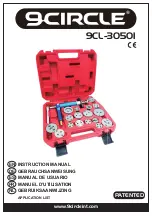
11
GB
O R I G I N A L I N S T R U C T I O N S
Vibration hazards
Exposure to vibration can cause disabling damage to the nerves and blood supply of the hands and arms. Keep the hands
away from the nutrunner sockets. Wear warm clothing when working in cold conditions and keep your hands warm and dry. If
you experience numbness, tingling, pain or whitening of the skin in your fingers or hands, stop using the assembly power tool
for threaded fasteners, tell your employer and consult a physician. Operate and maintain the assembly power tool for threaded
fasteners as recommended in the instruction handbook, to prevent an unnecessary increase in vibration levels. Do not use worn
or ill-fitting sockets or extensions, as this is likely to cause a substantial increase in vibration. Select, maintain and replace the
consumable/inserted tool as recommended in the instruction handbook, to prevent an unnecessary increase in vibration levels.
Sleeve fittings should be used where practicable. Support the weight of the tool in a stand, tensioner or balancer, if possible. Hold
the tool with a light but safe grip, taking account of the required hand reaction forces, because the risk from vibration is generally
greater when the grip force is higher.
Additional safety instructions for pneumatic power tools
The following additional warnings (or equivalent) shall be given with all pneumatic assembly power tools for threaded fasteners.
Air under pressure can cause severe injury:
- always shut off air supply, drain hose of air pressure and disconnect tool from air supply when not in
use, before changing accessories or when making repairs;
- never direct air at yourself or anyone else.
Whipping hoses can cause severe injury. Always check for damaged or loose hoses and fittings. Cold air shall be directed away
from the hands. Do not use quick-disconnect couplings at tool inlet for impact and air-hydraulic impulse wrenches. Use hardened
steel (or material with comparable shock resistance) threaded hose fittings. Whenever universal twist couplings (claw couplings)
are used, lock pins shall be installed and whipcheck safety cables shall be used to safeguard against possible hose-to-tool and
hose-and-hose connection failure. Do not exceed the maximum air pressure stated on the tool. For torque-control and continu-
ous-rotation tools, the air pressure has a safety critical effect on performance. Therefore, requirements for length and diameter of
the hose shall be specified. Never carry an air tool by the hose.
CONDITIONS OF OPERATION
Make sure the source of compressed air may create appropriate working pressure and guarantee the required flow of the air. If
the pressure of the air is too high, use a reduced with a safety valve. The pneumatic tool must be powered through a filter and a
greaser. It will guarantee simultaneously cleanliness and lubrication of the air with oil. The state of the filter and the greaser must
be checked before each use and, if necessary, the filter must be cleaned or the oil supplied in the greaser. It will guarantee proper
operation of the tool and will prolong its durability.
It is necessary to correctly adapt the reaction stick to a given task.
In the case additional holders or supporting stands are used; make sure the tool has been correctly fixed.
Adopt a correct position that will allow you to react to normal or unexpected movements of the tool that may be caused by the
turning moment.
Wrenches and other inserted tools must be adapted to work with pneumatic tools. The inserted tools must be in good working
order and must be cleaned and not damaged. Their size must fit the dimensions of the collector. It is prohibited to modify the
sockets of the wrenches or the collector.
OPERATION OF THE TOOL
Before each use of the tool, make sure that no element of the pneumatic system is damaged. If there are any damaged elements,
they should be immediately replaced with new, faultless elements of the system.
Before each use of the pneumatic system, dry the humidity that condensates inside the tool, the compressor and the dusts.
Connection of the tool to the pneumatic system
The drawing shows the recommended manner of connection of the tool to the pneumatic system. The presented connection
guarantees the most effective operation of the tool and will prolong its durability.
Place a couple of drops of oil (of viscosity SAE 10) to the air inlet.
Into the thread of the air inlet, turn strongly an appropriate terminal that makes it possible to connect an air supply hose. (II)
Install an appropriate terminal on the collector of the tool.
During work with pneumatic tools, use solely the equipment ap-
proved for work with percussive tools.
Adjust a correct direction of rotation. „F” indicates clockwise rotation, „R” – anticlockwise rotation.
Where it is possible, adjust the pressure (turning moment).
Connect the tool to the pneumatic system using a hose of internal diameter 1/2”. Make sure the resistance of the hose is at least
1.38MPa. (III)












































